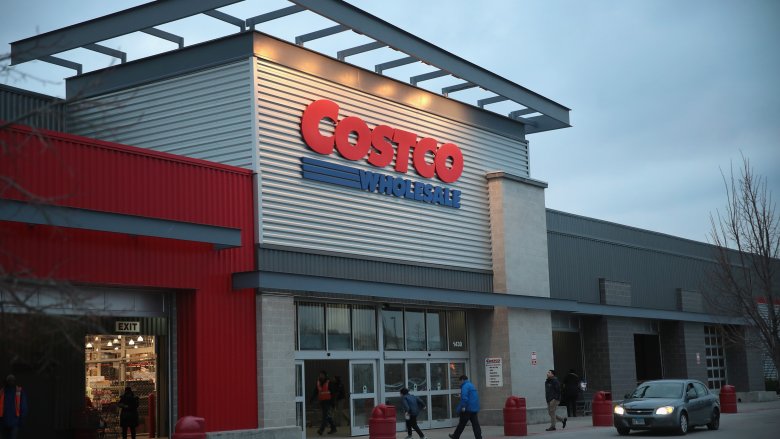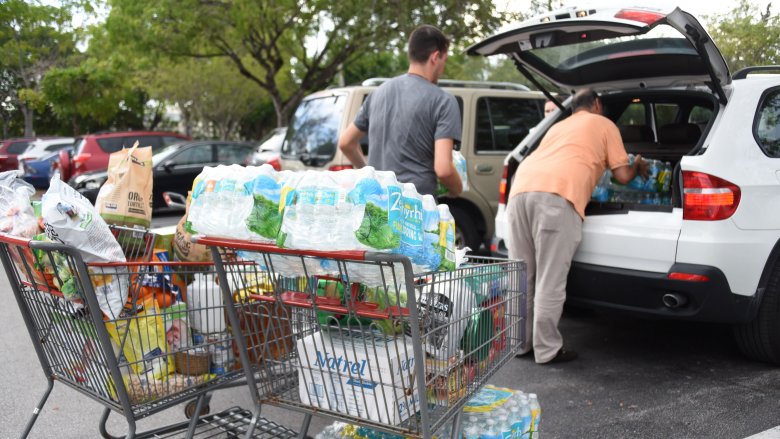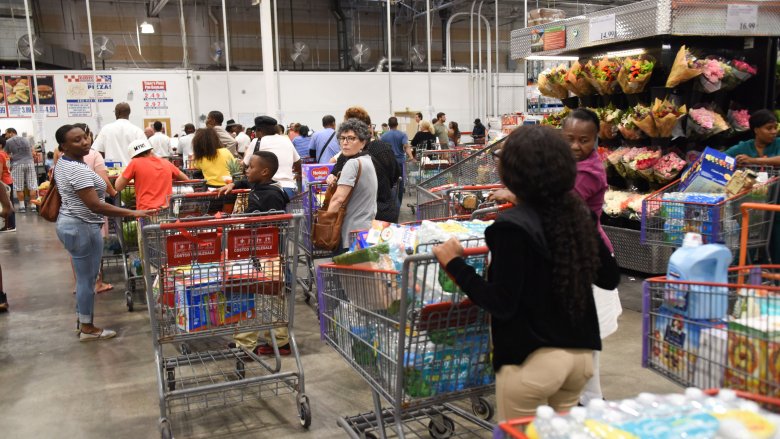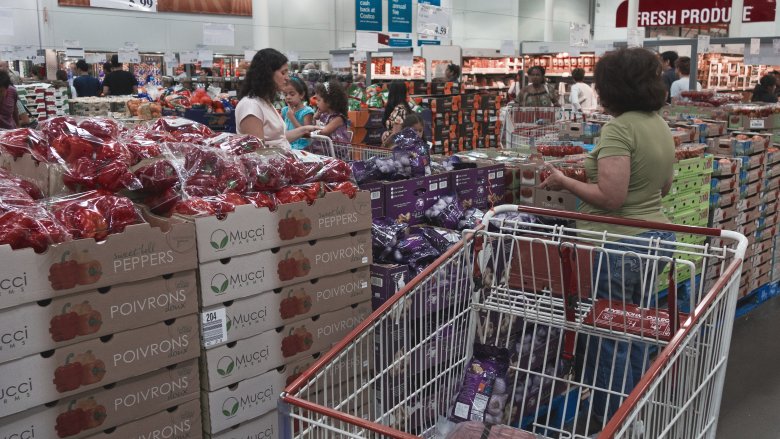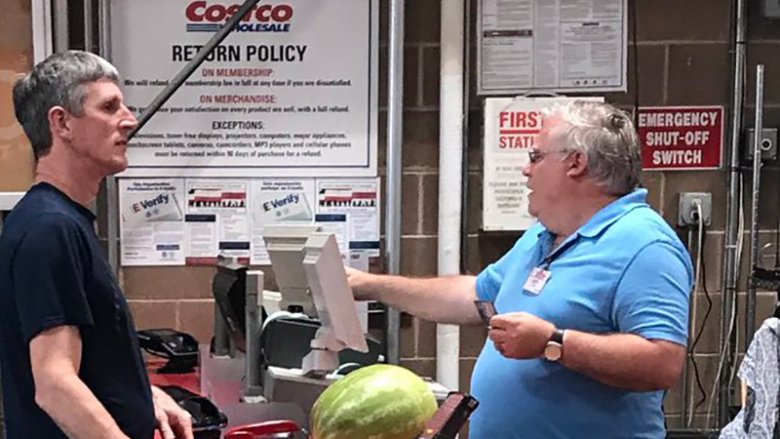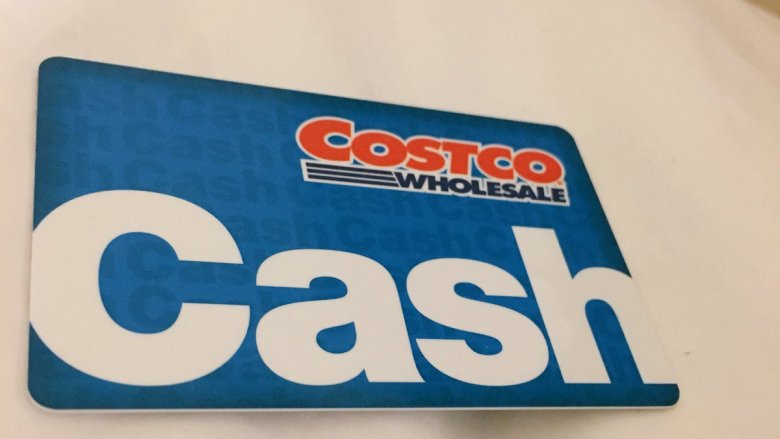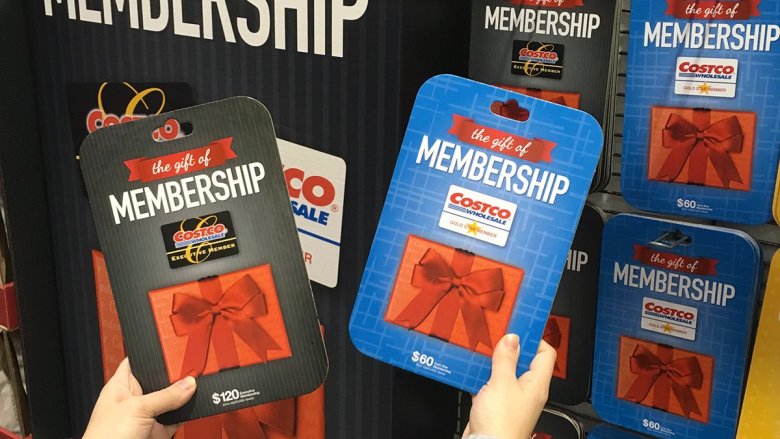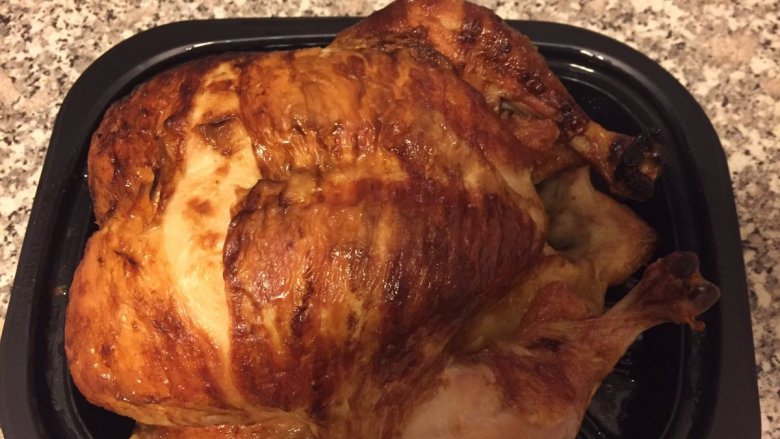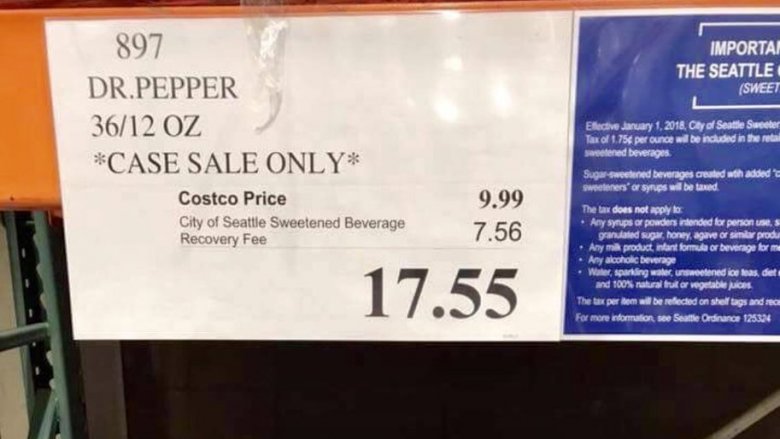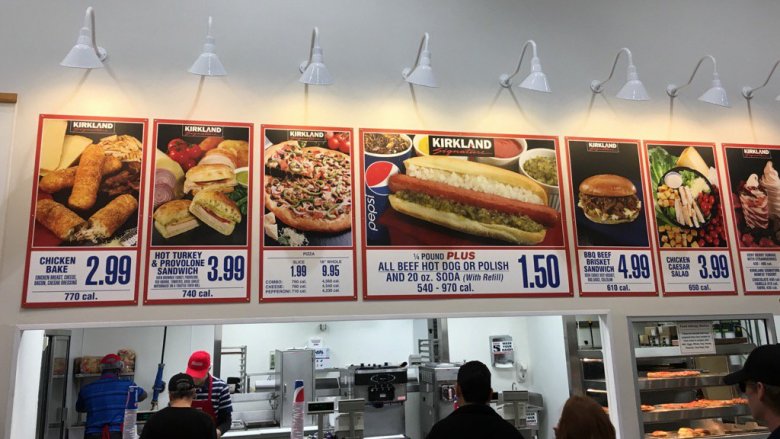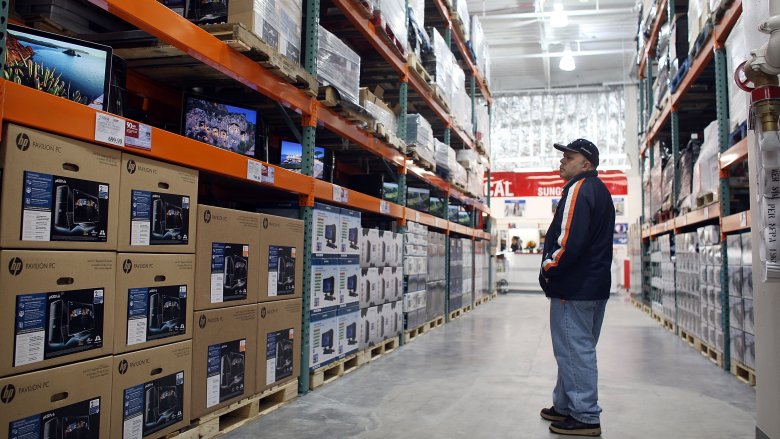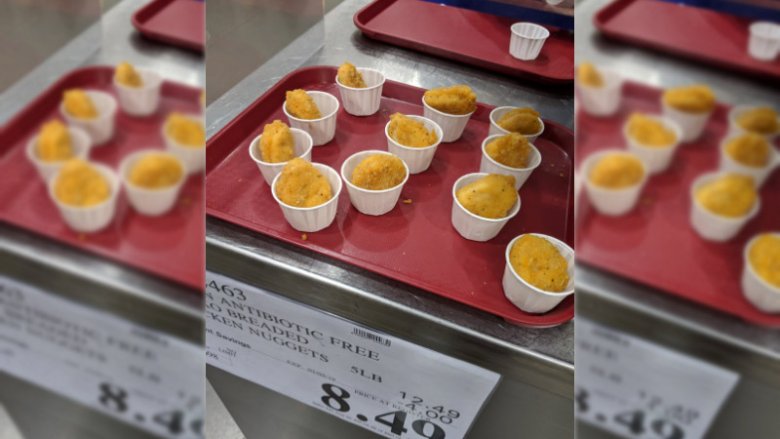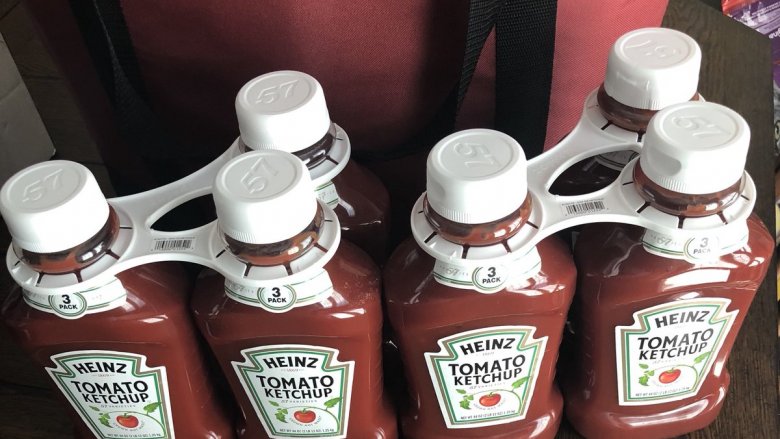How Costco Tricks You Into Spending More Money
As of 2018, Costco had 527 locations throughout the United States and Puerto Rico. It's a safe bet that on any given weekend, every one of those locations has a packed parking lot with customers combing through the store to load up on bargain-priced toilet paper and other must-have bulk items. Costco certainly has some amazing deals, and because of that, its no surprise that the billion dollar company continues to grow.
That growth is largely because Costco isn't just great at hunting down good deals — they're also great at getting you to spend your cash. From the second you step inside Costco, you grocery budget is in extreme peril and it's really only a matter of time until money you didn't plan on spending ends up in the Costco's bank account. It happens faster than you think.
Next to bugging Costco's marketing department, knowing these secrets are probably your best defense for avoiding an unplanned purchase. Take heed, Costco shoppers, and shop smart or risk falling into one of these Costco booby traps. Here's how they trick you into spending more money.
Their layout encourages impulse buys
All you came for was toilet paper and energy drinks, but to get there, you're going to have to walk past kitchen gadgets, fresh produce, sweat pants, wine, books, and those delicious smelling rotisserie chickens. There's a reason for that!
Costco's warehouse landscape can be a daunting thing to navigate and there are booby traps to catch your cash all over the place. One way the store works to get more of your money is by strategically laying out items in a way that encourages impulse spending. It's similar to how grocery stores have candy bars and magazines in the check-out line, but Costco takes it up a notch. It's nearly impossible to get around the store without encountering a few pitfalls.
According to a 2018 survey by Slickdeals.net (via CNBC), the average shopper in the U.S. spends around $5,400 per year on impulse buys. Costco knows that, and their layout is designed to capitalize on those habits. The store may place items that don't seemingly belong together, for example socks and light bulbs, to encourage impulse buying. Retail Designer Stan Laegreid calls it a "racetrack" design that functions with the purpose of leading customers past as many products, i.e. potential impulse buys, as possible.
If you feel a little guilty that Costco occasionally lures you in with the unplanned purchase, well, you can take a little comfort that your brain is just hardwired that way.
Items are constantly moved around
If you're a regular shopper at Costco, then you've probably experienced the frustration of grabbing laundry detergent one week and then going back to the same aisle a few weeks later, only to realize it's not there anymore. Well, friends, you're not going crazy. This is known as the Costco "treasure hunt" and it's all part of their psychological game to separate you from your hard-earned cash.
"They purposely move products around to different locations and are constantly rotating a certain percentage of their inventory to new products," Tony Jacobson a 13-year Costco vet wrote on Quora. "This creates a 'treasure hunt' experience as you shop and helps you discover new products that you may not normally see on your shopping visits."
Many of the aisles also don't have signs. According to CBS News, this makes you look even harder for that jumbo bottle of shampoo that keeps getting moved from week to week. When you consider the sheer size of a Costco store, looking for a single staple item that's always on the move can turn into quite the treasure hunt — and a much fuller cart than you planned on.
Limited time buys are a major trigger
Regular Costco shoppers know that it's not uncommon to see products offered during one trip that may not be available even a week later. The store regularly rotates products in and out. While this can be nice because you never know what great find may be awaiting you on each trip, it also creates a sense of urgency that many buyers can't resist.
"For A Limited Time Only!" is one of the oldest gimmicks in the book and it still works today in creating the fear of missing out (FOMO) response in shoppers. "FOMO is real," author and social psychologist Robert Cialdini told Inc. "Anything that plays to that fear — ticking clock emojis in an email marketing campaign, limited-time offers — can stoke that sense of urgency and that impulse to purchase."
According to Fast Company, Costco is an expert at using this instinct against us. They say that out of the 3,600 different items on Costco's shelves at any time, as many as 1,000 of them may be limited time offerings. Sure, customers can score some great buys, but the "while supplies last" warning also ensures they likely won't risk passing up a bargain. After all, who knows when you may find another 40-gallon fish tank or trampoline at such a low price.
The generous return policy is nothing more than a mind game
Costco has a pretty sweet return policy and will take back almost any item, even months from the time you purchased it. Pretty swell of them, right?
In reality, this "risk-free 100 percent satisfaction guarantee" return policy isn't just their way of showing customers extra special attention. Billion dollar companies typically aren't in the habit of that and it's actually an incredibly smart way of marketing that gets you to spend more.
By removing any self-doubt that you might get stuck with an item you don't like, Costco is betting that you'll be more likely to make a purchase. Because, hey, if those blue jeans make you self-conscious after a month, you can always return them.
What's especially weird, is that psychologists and marketing experts (which at Costco are basically one-in-the-same) have found the more lenient a store's return policy, the less likely the customer is to return the item. After all, without that strict deadline for returns, there's no rush to get it back to the store. And considering that 91 percent of consumers say a store's return policy factors into a buying decision, a generous return policy is a smart move.
In fact, it's exactly the type of marketing tactic that just might sway a customer to make an impulse buy on a limited time sale. And that's why Costco is king.
Even gift cards make you spend more money
You can't argue that Costco offers some pretty lucrative deals on gift cards. Just about every gift card under the sun is available, but the Costco Cash gift card is the real money deal for the store. The company knows that people are going to snag them up as easy gift items, and this gift card strategy works several ways toward getting you (and your loved ones) to spend. For starters, it gets old customers and even new customers into the store. One 2017 study found that 44 percent of people will visit a store they wouldn't go to otherwise because of a gift card, and you don't have to be a Costco member to spend Costco Cash.
The big way that Costco capitalizes on those gift cards though is by using them to pull a few extra dollars out of the gift card recipient's wallet. That's because most of us have a habit of spending more than the amount that's on our gift cards. In fact, when you arrive at Costco with the intention of using that gift card, you're likely to spend 20 percent over the value of your gift card. Shoppers with gift cards are also more likely to buy products at full price (hey, it's not really their money, right?), whereas they might hesitate or wait for a sale without one.
Membership fees suck you back in the door
People like to feel like they're a part of something, and Costco is capitalizing on this with a range of memberships to keep you feeling like a VIP. The trick is, those memberships not only get you in the door, they keep you coming back, too. With great membership comes great responsibility and it would be wasteful not to put that membership to good (and frequent) use, right?
"It's a big boost for customers to keep on going back in the store," Bloomberg business correspondent Sheila Dharmarajan explained. "If you pay the money for this membership fee you think 'I wanna use this' so you're going to keep going back to the store."
Even if some people might hesitate about paying for a membership to do their grocery shopping, 90 percent of customers renew their membership when it comes time to pay again. With that comes the subtle pressure to make good on the perceived savings from the membership card in their wallet.
The real kicker is that even if you don't regularly use your membership, Costco is still making bank from you, In 2015, Costco customers paid over $2 billion in memberships fees alone.
Good buys lead to bad decisions
Make no mistake about it, you can certainly find some really great deals by regularly shopping at Costco. If you're all about stocking up on batteries and frozen pizza, by all means, load that cart up! Unfortunately, finding just a few great buys at Costco can lead to frivolous spending in other parts of the store.
In retail, this is called the "loss leader" strategy. How it works is that a retailer will price one item below its market value to persuade consumers to make other purchases on products that have higher, more profitable prices. After all, you saved a ton on that one item, so it doesn't hurt to spend a little more on something else, right?
One of Costco's very well-documented loss leaders is its rotisserie chicken. Costco doesn't make zilch selling the birds for $4.99 and in fact, loses as much as $40 million a year selling them at that incredibly low cost. So why do they keep doing it?
The chickens encourage people to go to Costco and in turn, people end up spending more than they had planned. Take Kitchn writer Ayn-Monique Klahre for example. Klahre dug into several of her past Costco runs that were "just for chicken" but ended up making other impulse buys. In total, her excess spending for those bargain chickens added up to around $200.
The old 99 cent trick
Pricing something at 99 cents versus a dollar is an old retail trick. The secret isn't the 99 cents factor of the price, but the numeral digit to the left of it. Our brains place more emphasis on an item priced at $2.99 versus $3 than they do in the price difference between $2.59 and $2.60. So how's Costco work this to their advantage?
It's all about their price codes. Their prices are all over the map, ranging from items ending with 99 cents to 79 cents, to 88* cents, and even items priced evenly on the dollar. To the untrained eye it might seem like random pricing, but those prices reflect just how good a discount an item really is.
Prices that end in something like .49, .79, or .89 indicate that Costco got a deal from the supplier and a bargain is passed on to the consumer. Items priced .97 indicate that management has marked these items as stock priced to move. Items priced .88, .00, or with an asterisk* to the right of the price indicate the item is either discontinued or damaged and will not be replaced. These items tend to be especially discounted.
As for prices ending in 99 cents, well, Costco didn't get a deal from the supplier and these items are not marked with a discount price. Because of the left-digit effect though, our brains see Costco items priced at $9.99 as a much better deal than $10, when in fact, the difference is only a penny. More than likely though, you're already on to the next aisle with that item in your cart before your brain realizes you've been duped. And chances are, by then, you're going to buy it anyway.
The food court keeps you there longer
No trip to Costco is complete without a trip to the food court and one of their $1.50 hot dogs — at least that's how Costco wants you to feel. Costco's hot dog and soda combo has been the same $1.50 price since 1985. The company doesn't make any money on them and they're a total loss leader, similar to the rotisserie chicken.
"We're known for that hot dog," Costco co-founder Jim Sinegal told The Seattle Times. "That's something you don't mess with." The company isn't messing with its hot do and soda combo either, because it draws people into the food court, which in turn, keeps people in the store longer to potentially spend more money.
Walk into just about any Costco and you'll see the food court placed right up at the front of the store. "We want to catch you either on the way in or out of your Costco shopping experience, Costco's chief financial officer Richard Galanti said.
If you think you're safe eating your hot dog after you've already checked out, think about this. While you sit and devour your meal, you have plenty of time to watch the carts of everyone else on their way out the door — how many of those carts do you think will contain something you "must have"? Maybe enough to make you get back in line.
Even the warehouse look is to make you buy more
Some stores you walk into and the place just looks extravagantly expensive. Costco is definitely not one of those stores. The products are stacked on pallets, the floors are cement, and fluorescent lighting hangs from exposed beams. It all adds to the warehouse vibe that's meant to convey lower prices. Costco purposely tries not to make their stores look fancy, which makes you feel like their merchandise must not be, either.
"We try to create an image of a warehouse type of an environment," Costco's co-founder Jim Sinegal told CNBC. "I once joked it costs a lot of money to make these places look cheap. But we spend a lot of time and energy in trying to create that image."
The bottom line: If customers feel the store isn't spending a ton on decor, they're more inclined to feel they're getting low prices and load up their cart.
Free samples get you spending
You could make a meal out of walking around Costco and just eating free food samples. Try that on an empty stomach and you just might wind up buying a ton of stuff that wasn't on your shopping list. People love free food and giving away a taste can really boost sales.
Free beer samples at national retailers have been shown to increase sales by as much as 71 percent, according to The Atlantic. And free pizza samples, well, it's hard to argue against a tactic that increases pizza sales by 600 percent. According to Duke University behavioral economist Dan Ariely, Costco essentially guilt trips many of us into buying the product after trying the free sample.
"If somebody does something for you"—like handing you a single bite of delicious, cheesy pizza—"you really feel a rather surprisingly strong obligation to do something back for them," he explained. Like give them your money.
Not only does a free food sample translate to increased sales of the sample product being offered at Costco, but it reportedly makes for more loyal customers who in turn buy other goods.
They take away your choices
There's no question that Costco crams a lot of different stuff under its enormous warehouse roof. What you probably won't find though is a huge variety of any one particular product. Yes, you'll be able to find a huge bottle of mustard, but you're probably not going to have as many different mustard varieties and brands to choose from as you might find in the typical grocery store.
This is yet another example of Costco using some brilliant psychology to separate you from your money. "There was a research study in marketing that if you offer people 24 different types of jellies, you're not going to sell as many as if you offer them six," marketing consultant Pam Danziger said to CNBC. "Making people decide, that causes confusion, and they ultimately decide to walk away. At Costco, you don't have to make those decisions."
By offering up an item in bulk with just one or two varieties to pick from, Costco ups its chances of making the sale. Even if the customer doesn't need a 360-count bottle of aspirin, if that's all that's available they're more likely to buy it than if they had 12 different sized bottles or brands to choose from.
